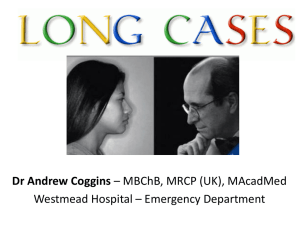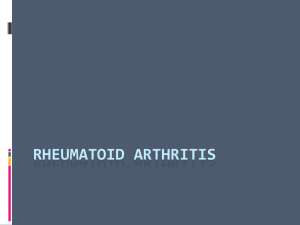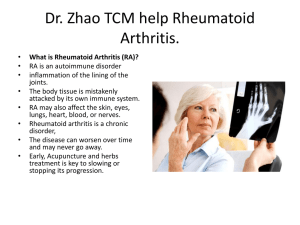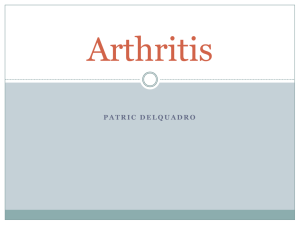Presentation
advertisement
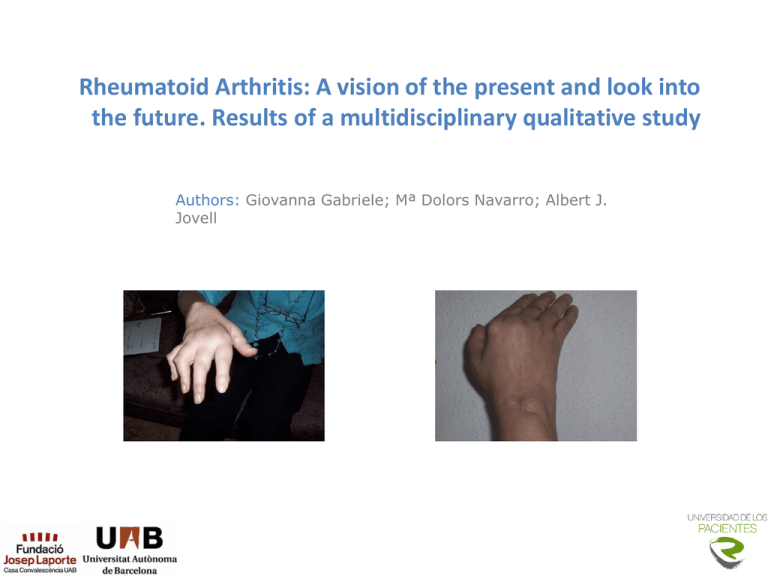
Rheumatoid Arthritis: A vision of the present and look into the future. Results of a multidisciplinary qualitative study Authors: Giovanna Gabriele; Mª Dolors Navarro; Albert J. Jovell Rheumatoid Arthritis: A vision of the present and look into the future. Results of a multidisciplinary qualitative study RESEARCH BACKGROUNDS (I) “The term 'musculoskeletal conditions' includes all conditions that affect the bones, joints, periarticular structures and muscles such as arthritis of all kinds, systemic disorders of connective tissue, back pain, bone diseases such as osteoporosis, soft tissue rheumatism and regional and widespread pain. Musculoskeletal conditions are common and their impact is pervasive. They are the most common cause of severe long term pain and physical disability. They significantly affect the psychosocial status of the individuals with the condition as well as their families and carers. They are a major burden on health and social care. In Europe 20 - 30% of adults are affected at any one time by musculoskeletal pain. The majority of the costs are indirect relating to social care, pensions and workers compensation. The burden can be reduced by a bone and joint healthy lifestyle and by identifying and managing in a timely way those at high risk or with the earliest features of a musculoskeletal problem. The effective management of musculoskeletal conditions requires integrated co-ordinated multidisciplinary, multiprofessional care focused around the needs of the individual.” European Board of Rheumatology, 2000 Rheumatoid Arthritis: A vision of the present and look into the future. Results of a multidisciplinary qualitative study People at the Centre of Health Care (OMS, 2007) Patient centred care is real when: 1.- People-centred is equitable; 2.- People-centred care engages all stakeholders; 3.- People-centred care is about empowerment; 4.- People-centred care is effective care; 5.- People-centred care is evidence-based and empathic; 6.- People-centred care is efficient; 7.- People-centred care is ethical. RESEARCH BACKGROUNDS (II) Rheumatoid Arthritis: A vision of the present and look into the future. Results of a multidisciplinary qualitative study RESEARCH BACKGROUNDS (III) Recommendations in musculoskeletal disease and in public and preventive medicine after postmodernism Brooks, P.M, 2006 - Muir Gray, J.A, 1999 system – - Leadership of the entire health system; Collaborative actions across all sectors; Multidisciplinary approach to all determinants; Political engagement in public health policy; Partnerships with the population to be serviced; Public spending / financial investment in social services. Establishment of a and patient-centred social and health through the construction of cross-sector partnerships education, transportation, labour and industry. Development of a multidisciplinary health and social approach focused on improving control and prevention of risk factors associated with the disease and understanding its impact in personal and social context. Rheumatoid Arthritis: A vision of the present and look into the future. Results of a multidisciplinary qualitative study RESEARCH BACKGROUNDS (IV) Recommendations in musculoskeletal disease: Written Declaration on rheumatic diseases The European Parliament, 2008 Attach more importance to rheumatic diseases in the new Community strategy on health, given their high social and economic costs; Encourage Member States to establish and promote the implementation of national plans to fight rheumatic diseases; plans to fight rheumatic diseases; Develop a Community strategy on rheumatic diseases and draw up a Council recommendation on the early diagnosis and treatment of rheumatic diseases; Develop a strategy to improve access to information and medical treatment. Rheumatoid Arthritis: A vision of the present and look into the future. Results of a multidisciplinary qualitative study RA SPAIN FACTS GUIPCAR. CLINICAL PRACTICE GUIDELINE FOR THE MANAGEMENT OF RHEUMATOID ARTHRITIS GUIPCAR Rheumatoid arthritis (RA) affects some 200,000 persons in Spain, with 20,000 new cases emerging each year. RA reduces quality of life and functional capacity, produces work disability, and increases mortality. It has been estimated that the annual cost of RA in Spain exceeds 1.120 mill/Euros. There is evidence of large variability in the management of RA in Spain; this variability depends not only on patient or disease characteristics, but also on characteristics of the hospital, department, or physician providing patient care. These facts suggest that some diagnostic or therapeutic procedures are overused, while others may be underused. For these reasons, in 1998 the Spanish Society of Rheumatology (SER) decided to develop a clinical practice guideline for the management of rheumatoid arthritis (GUIPCAR) to help physicians make decisions about the diagnosis and treatment of patients with RA. The objective of GUIPCAR is to develop standards of quality for the treatment of RA and to reduce the variability that does not depend on patient characteristics. Rheumatoid Arthritis: A vision of the present and look into the future. Results of a multidisciplinary qualitative study RA FINDINGS EPISER EPISER Research 2000. Findings in Rheumatoid Arthritis (SPAIN) I. The prevalence in RA in the Spanish population over 20 years is 0.5%, slightly higher than in other countries of the Mediterranean but less than the AngloSaxon countries. II. The prevalence is higher in women between 40 and 60 years. III. There are undiagnosed cases of RA in the general population. May be individuals with limited functional capacity. IV. Treatments with demonstrated efficacy in RA are not used systematically in patients with RA in the general population. V. RA affects significantly the quality of life of people affected (patients /relatives). VI. Lower prevalence in rural areas. This hypothesis should be examined in depth in future studies. Prevalence and impact of rheumatic diseases in the adult Spanish population. (EPISER 2000) Rheumatoid Arthritis: A vision of the present and look into the future. Results of a multidisciplinary qualitative study RESEARCH PURPOSE AND OBJECTIVES Purpose of the Research Identify in which way health and social system is centered on the patient and their relatives and identify key strategic lines of improvement in order to provide a better and more effective response to needs in rheumatoid according to patients, families and professionals views and experiences. Objectives Explore scenarios and care experience of RA in the phases of pre-diagnosis, diagnosis, continuity and follow-up care, and social and labor adaptation of the patient and family. Initial contact with the health system System Response Interventions made by the healthcare team Level of centralization of care in the patient and family Continuity and follow up Social acceptance Work adjustment Rheumatoid Arthritis: A vision of the present and look into the future. Results of a multidisciplinary qualitative study RESEARCH QUESTIONS Key Research Questions What is the level of centralization of health and social system on patient and family with regard its adaptation and response to disease and specific context of RA?; Do reflect the RA approach a care quality pattern based on the right of the patient to be diagnosed and treated at the right time? What is the impact of RA at the special relationship and navigation of the patient and family in the health and social system? What are the factors modulating AR-specific behavior that positively and negatively affect the perception of health status of the patient and family? What actions and recommendations could be suggested to improve care and adaptation of health, social and labor dimensions to patients, families and professionals needs? RESEARCH METHODOLOGY (I) Rheumatoid Arthritis: A vision of the present and look into the future. Results of a multidisciplinary qualitative study QUALITATIVE APPROACH QUESTIONARY DESIGN LITERATURE REVIEW CONSTRUCTION DIMENSIONS STUDY INTERVIEW EXPERTS (N = 16) (15-30 RA and MSDs years of experience) FOCUS GROUP PATIENTS ( N = 11) FOCUS GROUP RELATIVES ( N = 7) FOCUS GROUP PROFESSIONALS ( N = 10) Metthodology Diagram IDENTIFICATION OF AREAS FOR IMPROVEMENT RECOMMENDATIONS DISCUSSION OF RESEARCH FINDINGS PROFILES OF RESEARCH ANALYSIS Rheumatoid Arthritis: A vision of the present and look into the future. Results of a multidisciplinary qualitative study Inclusion Criteria for Focus Group Patient Focus Group Relatives Focus Group Professionals Focus Group • Age: (18-29), (30-39), (40-60), (61- • Age: > 18 • Gender: men and women 70) • Gender: men and women • Health system: public and • Gender: men and women • Population: general and private • Population: general and immigrant immigrant • Profession: General Practice, • Diagnostic: AR of long evolution and • Diagnosis of the relative: AR of Rheumatology, Nursing, early RA (1-3 years) long evolution and early RA (1-3 Physiotherapy, Occupational • Employment status, occupation and years) Therapy, Management, Pain family structure support • Employment status and Unit. occupation •Professionals affected by RA • Degree of relationship (marriage / domestic partnership.) Rheumatoid Arthritis: A vision of the present and look into the future. Results of a multidisciplinary qualitative study RESEARCH INSPIRATION RA PATIENT NAVIGATION Navigation Route in rheumatoid arthritis. Source: Susan Oliver. Nurse Consultant Functional Impact Psycho-emotional Impact PAIN Life Experience of Rheumatoid Arthritis Social Impact Labour Impact SELF-PERCEPTION Rheumatology. Nurse Advisor to National Rheumatoid Arthritis Society, 2009. QUALITY OF LIFE RA Study Diagram: Dimensions and Determinants of Life Experience Rheumatoid Arthritis Rheumatoid Arthritis: A vision of the present and look into the future. Results of a multidisciplinary qualitative study RESEARCH MAIN FINDINGS (I) “Every day you wake up with a disease that determines you from the first moment of the day. You need a different concept of time and a different rhythm from anyone else. [...] I do not remember in 24 years, wake up one day without pain. The whole day is affected by fatigue. Aside from having the disease, also weekends I get to be a caregiver, I have to take care of my mother who is an elderly person with problems of obesity and that also complicates my illness.” (Patient and Caregiver) “Every day is really an unknown. It all depends of how fine is she. We try to focus single in function of this, do not make plans. What is a good day? A good day is when she has not pain. When she has an adequate mobility.” (Patient’s relative) “The problem still remains the care circuit, how not to delay the early care and diagnostic. We must further develop more the rheumatology care dispositive outside hospitals and coordinate it more with Primary Care.” (General Primary Care Professional) “I just remembered a person who needs support and help. A person who has undergone a rheumatoid hand surgical intervention , completely deformed. And come to us, I do not know if she is 40 years or less ... not much more... She could not to do anything. A person that needed home care attention during three or four months, only for the period of convalescence. But they have denied her the assistance. Look, it is a terrible distress.” (Occupational Therapy Professional) “The patient comes to the follow-up consultation and we limit us to apply him our clinical and analytical parameters, how is the status of Rheumatoid arthritis… and very often we not ask the patient about other important things. We limit us to check a questionnaire, which scores so and so. Perhaps it would be better to deepen more about patients’ limitations or about the impact that this disease is having in his life.” (Rheumatology Professional) Rheumatoid Arthritis: A vision of the present and look into the future. Results of a multidisciplinary qualitative study RESEARCH MAIN FINDINGS (II) Confirmed Initial Hypothesis of Research This research confirms the EPISER findings affecting both scenarios the early and the longstanding RA opening up new lines of research and interventions in RA • The subjective perception of health and quality of life of patients with RA is more positive with a multidisciplinary approach than without, and especially in pain, though is still the rheumatologist the most influential figure with regard to RA approach. • The early and effective social and labour integration of patients with RA as well as the early and multidisciplinary interventional approaches to pain management increases the quality of life and reduces the consequences derived of outbreaks and joint affectation and deterioration. •Presence of a personal (family), social support (RA Patients’ associations) and anticipated diagnosis, treatment and pain management are the most relevant health determinants in patients with RA and their families, from both points of view: clinical and psycho-emotional. • The degree of RA patient centeredness is a crucial indicator in health system care but also in social and labour spheres (for linkages between health and environment –personal context) that affects directly the patients’ and relatives’ health, wellness and quality of life. Rheumatoid Arthritis: A vision of the present and look into the future. Results of a multidisciplinary qualitative study Patients Pain views against GUIPCAR Standards RESEARCH MAIN FINDINGS PAIN (I) “It's an incredible pain, everything hurts, it hurts here, my spinal column hurts, everything hurts. [...] I can not do anything. My doctor tells me: 'You have a great ability to endure the pain ...'. I say to him, ‘because I have no choice’…” (P5, woman, 24 years, administrative) Diagnosis 2009 A GOOD DAY “A good day is when you get up and do not complain out loud.” (P10, man, 46 years old, disability leave) 2000 Diagnosis A BAD DAY "[...] A bad day is when I get up and I have pain, lower back pains are horrible, but the day my feet and knee joints hurt ... that's the worst ” (P7, woman, 48 years, administrative, unemployed) Diagnosis 2008 "Every day in pain. The day that you do not complain ... is the best and worst day is when you wake up at four o'clock and you can not sleep, you start to take what you catch for home- Nolotil or whatever-and you think, I have to go to work and anything take away my pain.” (P9, woman, 49, technician labour) Diagnosis 1977 Rheumatoid Arthritis: A vision of the present and look into the future. Results of a multidisciplinary qualitative study Professionals Pain views against GUIPCAR Standards RESEARCH MAIN FINDINGS PAIN (II) PROFESSIONALS “We should take care of patients before they start to have functional problems and pain. If that is done at first, it is possible to avoid and prevent further injuries and to make patients more aware about the importance of take care of their joints.” (Pf3, physiotherapy professional) When we take care of people with rheumatoid arthritis, it is already too late. I don't know if patients come to us with important delays but already when they arrive, their actual state is a absolutely disaster. These are patients who in 10 or 12 years have had a disabling pain which nobody has known how to treat. A severe pain associated with depression, anxiety, insomnia, incapacity and inability to relate to anyone. “ (PF8, pain specialist pain unit, man) Rheumatoid Arthritis: A vision of the present and look into the future. Results of a multidisciplinary qualitative study RESEARCH MAIN FINDINGS PAIN (III) Professionals and Patients Pain views against GUIPCAR Standards PROFESSIONALS “Many times people before being well diagnosed and put the label as a rheumatoid arthritis wanders for many specialties. Sometimes there are important delays in diagnosis and that is the main constraint for the prognosis and future degree of RA damage. This is probably one of the more important determinants by which we see so deteriorated and evolved rheumatoid arthritis.” (Pf6, primary care and management professional) PATIENTS “I think that the main barrier that we have many of us is the labour issue: I am 46 years old and I have a disability leave with a reduction of the 55% of what I won. How can you make ends meet on a single income when your wife is unemployed and you have a son? How it would be possible to lead a normal life?. It is impossible. When you are relatively young and living off 55% of your income. How do you can face this?[…].” (P10, man, 46 years old, disability leave) 2000 Diagnosis RESEARCH MAIN AREAS OF IMPROVEMENT Rheumatoid Arthritis: A vision of the present and look into the future. Results of a multidisciplinary qualitative study Information and Knowledge Early Diagnosis and Treatment Multidisciplinary Care Approach 1.- Promotion and diffusion of information and 1.- Construction of an workflow for 1.- Multidisciplinary approach to patient knowledge about the AR. coordinated inter-health-systems and family in order to guarantee the provide care on RA through flexible and quality of the RA follow-up as well as in 2.- Important role played by the Patients structured circuits and processes in order Association, especially in RA patient and health care interventions. relatives at risk. Patient-Centredness Care Care Coordination Follow-up Care 1.- Social care and attention focused on the 1.- RA Map Road for a persons affected 1.- A better follow-up of patient patient and family needs. by RA focused on patient and family affected by RA establishing and assessment more intensive and maintaining effective therapeutic personalized (individual care plans). relationships in order to guarantee to identifying patients and caregiver information, knowledge and Health and social navigation. effective performance goals according the respect and integration of single professional roles. Rheumatoid Arthritis: A vision of the present and look into the future. Results of a multidisciplinary qualitative study CONCLUSIONS (I) (1) RA is a highly complex and disabling disease for which approach is needed a large number of human resources and health care based on the following areas: a.- Prevention, diagnosis, referral and treatment of RA in early stages; b.- Anticipating clinical intervention by rapid escalation in the treatment; c.- Early and continued intervention in the social sphere; d.- Multidisciplinary care approach. (2) Health system is not centralized in the patient and family and is more oriented to the clinical dimension than to the family and relatives impacts at the household, social and labour dimensions. That implies the need for a more personalized and humane care taking into account the type of RA and being more sensitive to the AR patient profile and understanding (silent voice) (3) The high fragmentation of health systems, social and labour affects deeply the early diagnosis and treatment; the secondary prevention (especially important in improving the prognosis, the level of functionality and the avoidance of joint) and the tertiary prevention (intervention on physical and psycho-emotional pain, crucial in the avoidance of loss of autonomy). All these aspects have a negative impact on the proactive integration and progressive adaptation of the patient to the social and labour fields. (4) High degree of variability in clinical practices -access to early diagnosis and treatmentregardless of the existence of protocols and clinical practice guidelines specific for RA as GUIPCAR (2007). This variability depends primarily of the following factors: a.- The existence of not of specialized care units on RA and Pain; b.- The level of care that makes the intervention focused on RA identification and referral c.- The degree of professional knowledge and expertise; e.- The human and financial resources available. Rheumatoid Arthritis: A vision of the present and look into the future. Results of a multidisciplinary qualitative study CONCLUSIONS (II) (5) Difficulty to access to health care services established outside of care circuits with a substantial impact on quality of life because are heavily dependent on the purchasing power of patients forcing to pay these services (psychological approach and complementary therapies: e.g.: balneotherapy). (6) High level of delayed access to biological and pain treatment for common discrepancies about standard recommendations, cost-effective reasons and high turnover of professionals in the respective health centres or units.+ (7) Important lack of information and knowledge before diagnosis are perceived by patients as the main causes of the diagnosis and treatment delays and also as a direct result of joint deterioration. All the patients and family members interviewed confirmed to be aware of being affected by RA after diagnosis, greatly improving their RA knowledge in the interaction with the Patients Association. (8) Important lack of access to educational support and to RA individual care plans being the main source of patient information, knowledge and education map navigation as well as a link between personal, clinical, social and labour context the RA Patients’ Associations. This research evidence the existence of a high level of disparity in the timeless of AR diagnosis and treatment, sometimes exceeding one year or more, against current GUIPCAR recommendations and standards. Rheumatoid Arthritis: A vision of the present and look into the future. Results of a multidisciplinary qualitative study FUTURE IMPLICATIONS FOR RA PRACTICE Knowing and meeting patient journey and pain impact should be a central aspect and a priority of RA practice and Public health and preventive medicine in a changing Europe, in a critical economic European Union, especially with regard the current restructuring European Health, Social and Labour Systems. Undervalued this will affect the efficacy, efficiency, equity and social justice of contemporary health care. Health, social and labour care should work with patients associations and relatives and promote their engagement and participation in order to focus the care to the RA impacts, to avoid the loss of “therapeutic / social and labour integration windows” and to ensure the implementation of professionally endorsed recommendations, standards and guidelines. We need news ways of working and redesign RA services from point of view of gaps and failures (e.g. individual patient RA/Pain care and management, early and long-term RA follow-up in the community setting, integrated pathways of the patient and relatives journey, implementation of National Strategies for Health specific cross-cutting RA and pain and implementation of specific programs for AR common to all relevant stakeholders.…) Undervalued patient and relatives RA needs and preferences in pain will provoke to many losses related to personal autonomy and freedom, social life, and security and stability for the caregiver experienced as negative change in familiar partnership/relational patterns. Caregiver and patient vulnerability risk in a current economic crisis will be increased for the coexistence of social relevant determinants such as poverty, unemployed, low education level, coexisting health conditions and barriers to essential health services access. Intervention strategies should address coping facilitators and barriers as identified by patients and caregivers. Rheumatoid Arthritis: A vision of the present and look into the future. Results of a multidisciplinary qualitative study "Every country in the world recognizes the huge benefits of investing in health. Healthy children are better students. Healthy adults are more productive workers. Healthy families can make greater contributions to their communities. And when we live longer, healthier lives, we have more time to do our jobs, play with our children, and watch our grandchildren grow up.” World Medical Association, 22 May 2012 Thank you very much for your attention! http://www.universidadpacientes.org E-mail: joana.gabriele@uab.es CONTACT Disclosure Statement of Financial Interest I, (Joana Gabriele Muñiz) DO NOT have a financial interest/arrangement or affiliation with one or more organizations that could be perceived as a real or apparent conflict of interest in the context of the subject of this presentation.
